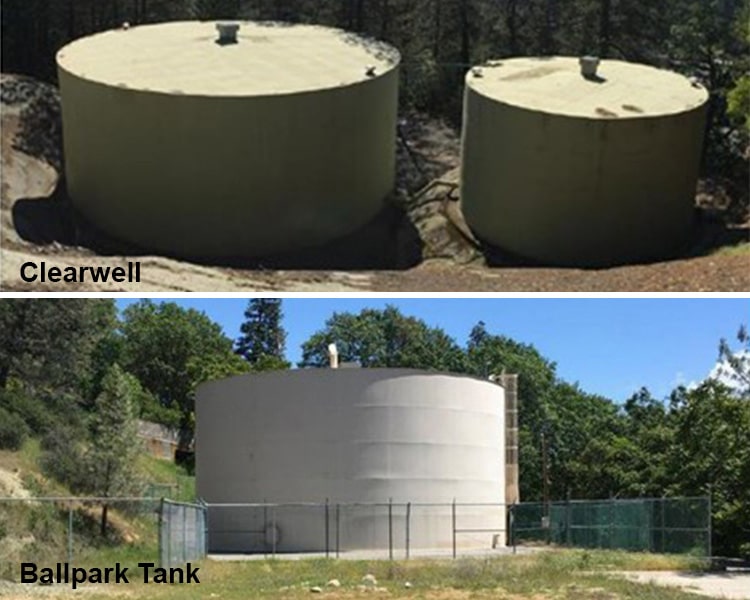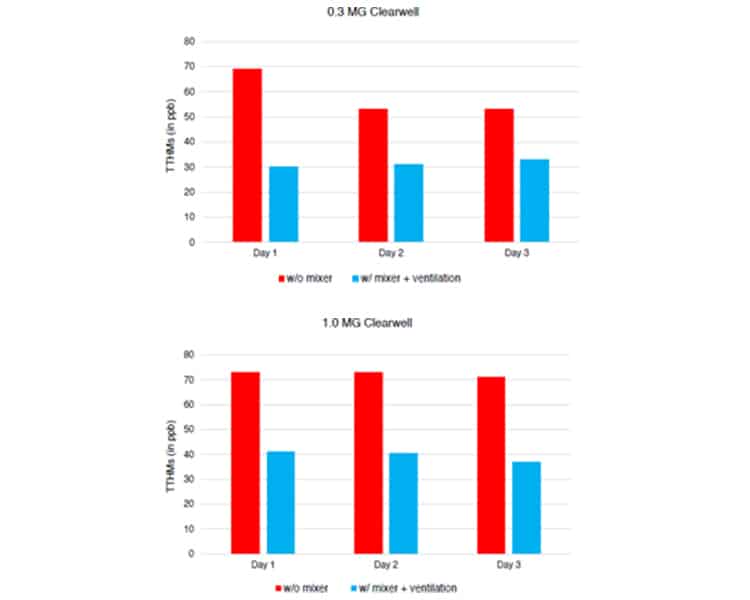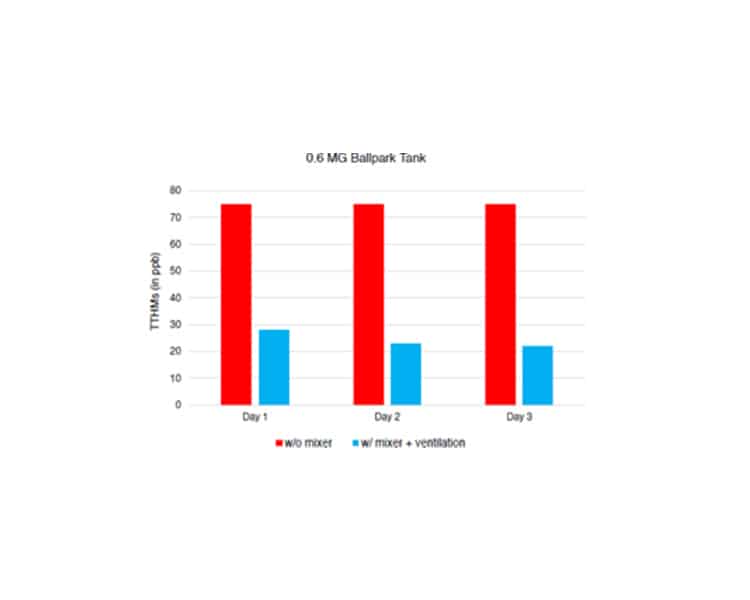Project Summary
Customer
Placer CountyWater Agency, CA

Type of Project
Tank Mixing and Coaxial Tank Ventilation Systems
Results
- The PAX Water Mixer and Powervent® were able to remove 45% of the THMs in each of the two clearwell tanks, and 65% of the THMs in the 600,000-gal Ballpark Tank.
Relying on surface water captured by the Sierra Nevada mountain range, Placer County Water Agency (PCWA) provides drinking water for over 200,000 people in cities, towns and communities along Interstate 80 in the heart of California’s “Gold Country.” Serving an area of over 1,500 square miles, PCWA runs multiple water treatment plants for large populations such as their Foothill/Sunset system (population 83,394) and smaller systems for cities like Colfax (population 3,079).
A few years ago, operators saw trihalomethane (THM) levels spike in February and again in May. By the summer, PCWA faced a THM crisis. Drought across the western United States had led to increased levels of organic matter in the source water. In addition, water conservation measures had lowered water usage, resulting in higher water age in their distribution systems.
Higher organic levels required greater levels of chlorine disinfectant, which increased THM levels during treatment. Higher water age allowed THM formation to grow further in the distribution system. After registering an Operational Exceedance for THMs in the early summer, PCWA quickly took action.
System flushing is one of the most common operational methods for reducing water age and lowering THMs, but it becomes problematic during a drought. “Flushing was always an option, but we would be sending mixed messages by telling people to save water while we dumped a bunch of water on the ground,” said PCWA Drinking Water Operations Manager, Andy Hamilton.
PCWA staff challenged themselves to quickly identify and address locations where THMs were on the rise. “We have always been concerned about THMs,” noted Hamilton, “but we didn’t have a way of assessing THM levels beyond the quarterly [compliance] sampling. A two week delay between shipping water samples and getting results was a big issue.”
At the request of Brad Wilkins, Water Quality Supervisor, PCWA decided to trial a Parker Hannifin desktop THM analyzer to gain greater insight into the specific locations where THMs were the greatest problem and to understand how THM analyses could be used to better optimize treatment and distribution. The small desktop unit uses helium and an advanced set of sensors to provide highly accurate species-specific THM analyses in drinking water in 30 minutes.
“
Prior to installing the PAX Water Mixers, we were seeing THM levels in our tanks into the 70s and 80s during warmer months. Our most recent samples were in the 30s and 40s. I’m confident those levels will stay much lower than we were seeing before.
— Brad Wilkins, Water Quality Supervisor, PCWA

Important discoveries
PCWA operators made an important discovery: THM levels were forming quickly during primary treatment, and THM levels in the clearwell tanks at the Colfax system were particularly high. Treatment plant operators experimented with lowering the chlorine pre-feed into the treatment plant and saw a substantial reduction in THMs.
With the insights gained from the analyzer, PCWA operators then explored options to further reduce THMs in the clearwells and in distribution system tanks.
Webinar trainings by PAX Water Technologies had shown PCWA staff how the addition of full aeration systems inside water storage tanks could strip THMs from finished drinking water. But under a tight deadline and with limited emergency funds, PCWA wanted to explore how much THM reduction they could achieve with active mixing and active ventilation alone.
PAX Water Mixers continuously push THM-rich water up to the surface where the THMs can evaporate out of the water into the headspace of the tank. The PAX Powervent® is a high-efficiency ventilation system, designed specifically for water storage tanks, that will exhaust the THM-rich air out of the tank.
Meaningful results
Some of the targets for improvement were a pair of welded steel tanks (1MG and 300,000-gal) that made up the clearwell and a 600,000-gal “Ballpark Tank” in the Colfax distribution system. PCWA installed PAX Mixer/ Powervent combined systems in each of the two tanks, and initial results were very encouraging. Operators saw an immediate and substantial reduction in THMs leaving the clearwell tanks, and the Ballpark Tank also saw substantially lower THM levels compared to historical values.
One of the initial concerns was chlorine loss, but after installation and operation of the PAX Water Mixers, Hamilton and his team observed that chlorine levels remained stable. “We have been able to maintain residuals just fine,” he said.
In addition, before installing the mixers, Hamilton’s team observed that residual levels dropped as the Colfax tanks drained. But after installation of the PAX Water Mixers, this was no longer the case. “That’s another big benefit: The tanks are homogenized,” he noted.


After running the mixers and Powervents for a year, utility managers were eager to quantify exactly how much THM reduction they were achieving with the new technology. The results were impressive. The PAX Water Mixer and Powervent were able to remove 45% of the THMs in each of the two clearwell tanks, and 65% of the THMs in the 600,000-gal Ballpark Tank.
“I think the magnitude of THM reduction from just the PAX Water Mixer and the PAX Powervent surprised everyone. We knew the PAX Water Mixer was powerful…but we did not anticipate the efficiency with which the Mixer and Powervent could reduce THMs without any additional aeration equipment. Our results so far suggest that it is by far the most energy-efficient means of lowering THM levels available,” explained Dr. Robin Giguere, R&D Scientist, PAX Water Technologies, a UGSI Solutions Company.
“
We knew the PAX Water Mixer was powerful… but we did not anticipate the efficiency with which the Mixer and Powervent could reduce THMs without any additional aeration equipment. Our results so far suggest that it is by far the most energy-efficient means of lowering THM levels available.
— Dr. Robin Giguere, R&D Scientist, PAX Water Technologies
